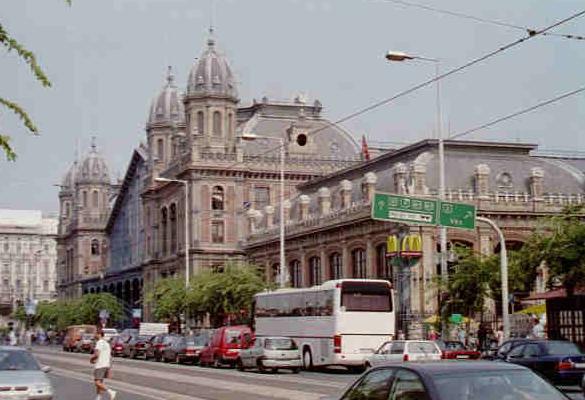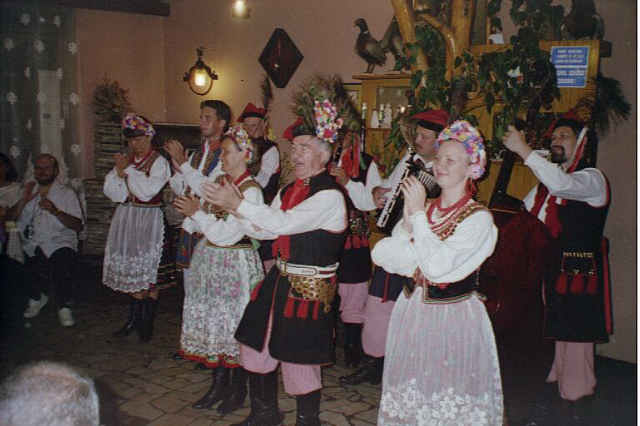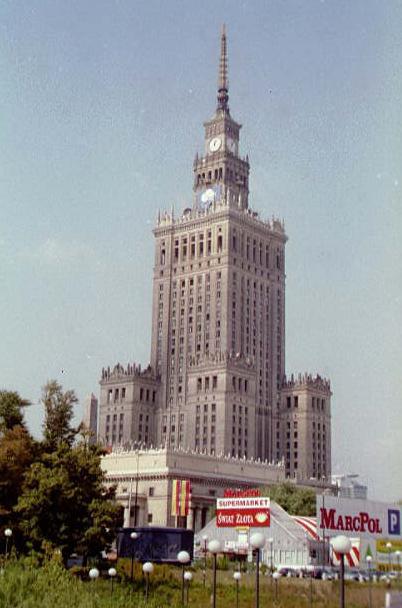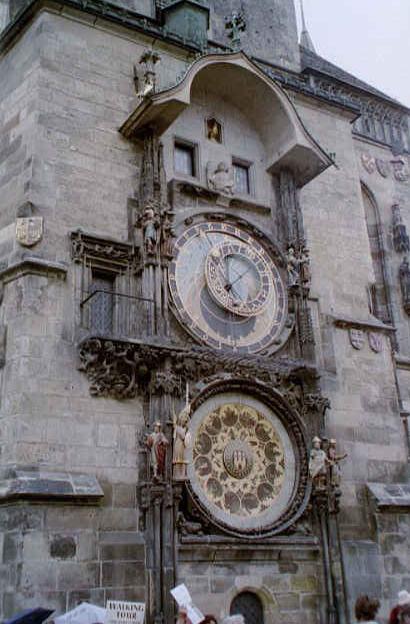Eastern Europe
(If It’s Tuesday, it Must Be Warsaw)

I was stationed in Germany for two years from 1975-1977 during which time I traveled all over Western Europe, the Middle East and the U.S.S.R. Except for Russia and one trip to Berlin, I never visited the Eastern European countries, which were under Communist rule at the time. I have wanted to visit Eastern Europe for many years and figured the time was right so I signed up for Trafalgar Tour’s eight-country tour by bus. The entire tour lasted 18 days from August 16 to September 2, 2001. It included Austria, Slovenia, Croatia, Hungary, Slovakia, Poland, Germany and the Czech Republic.
I had one of my best flights and one of my worst flights on the way to Vienna. I was able to get a free first class upgrade from Sacramento to Atlanta on a Delta Airlines B-757, which was really nice. Then from Atlanta to Paris on an Air France B-747-400, they wouldn’t give me an exit seat with more legroom because I don’t speak French (I worked 18 years in Aircraft Crash Rescue. I think I can shove people out of a burning aircraft without knowing French but rules are rules – you have to be able to follow instructions). When I asked for a bulkhead seat, they insisted that it didn’t have more legroom (they lied). Anyway, I ended up with a seat crushing my knees the whole flight – of course I didn’t sleep on the overnight flight. Why is it the larger aircrafts have less legroom than the smaller aircraft? Anyway, I made it to Vienna where I met my roommate Art whom I met two years earlier on another Trafalgar tour. I went to bed at 10:30 p.m. but even though I had been awake for what seemed like two days, I woke up at 3:30 a.m. and couldn’t get back to sleep. I was looking forward to getting on the bus where I could finally sleep!
Our tour director was Janusz from Poland. Janusz speaks ten languages and he taught us about ten words of the local language before we entered each country. He also gave us a history lesson from the Roman times to the present of each country – all from memory. I’m a history buff so I tried to stay awake for that. Our driver was Eric from Austria. I got to practice my German with him even though he also spoke English.
 Our first stop was Lake
Bled – a beautiful resort in the Julian Alps in Slovenia. Slovenia was the
first republic to break away from Yugoslavia in 1991. After a 10-day war, they gained independence. We took a gondola
ride to the island in the middle of the lake that has a church on it and saw Tito’s
“hunting house” – animals were brought there so he could “hunt” them from his
balcony. We also visited the castle
overlooking the lake and went to a bee museum in Bled.
Our first stop was Lake
Bled – a beautiful resort in the Julian Alps in Slovenia. Slovenia was the
first republic to break away from Yugoslavia in 1991. After a 10-day war, they gained independence. We took a gondola
ride to the island in the middle of the lake that has a church on it and saw Tito’s
“hunting house” – animals were brought there so he could “hunt” them from his
balcony. We also visited the castle
overlooking the lake and went to a bee museum in Bled.
The next day we left for Ljublijana, the capital of Slovenia. President Bush had just met Russian President Putin there a few weeks earlier. In Ljublijana as in each city, we had a local guide give us a tour. Most tours included walking around the old towns as well as using the bus. I took an optional tour to the Lipizza Stud Farm where they breed the famous Lippizaner horses that perform in Vienna, Austria and the Postojna Caves. I’ve been to many caves but this was the first one that included a wild open car train ride into the caves.
The next stop was Zagreb, Croatia. Croatia also declared independence from Yugoslavia in 1991 and was at war off and on from 1993 to 1995. On the way to Plitvićka Jezera National Park, we drove through the small town called Tarań. Virtually every house was either destroyed or damaged. It was very strange seeing really nice two and three-story houses along the main road where it looked like someone just randomly shot at them with automatic weapons. Some of the houses had been rebuilt but most were still grim reminders of the war that included “ethnic cleansing”. In the National Park, we took a boat ride and hiked along several lakes – each one dropping in elevation by waterfall. The water of the lakes was very clear but also a turquoise color due to a type of algae. It was nice to get out and hike through the woods after being on the bus for several days – a great optional tour.
From Croatia, we headed to Budapest, Hungary stopping at Lake Balaton, at 77 km long, the largest freshwater lake in Europe outside of Scandinavia. Budapest is a beautiful city. I took the optional dinner cruise on the Danube River to see all the buildings and bridges lit up at night. After the cruise, Art and I and several other party animals from our group ended up at the “Old Man’s Pub” where we met two local women who happened to be sisters – Beatrix and Szilvi. It’s always nice to meet the locals and I’m still in contact with them via email. One bad thing about a tour like this is the early wake-up calls – usually around 6 a.m. but I wasn’t going to let that keep me from going out at night – I figured I’ll sleep when I get home (or on the bus).
 The next day instead of
an optional tour, I took the subway on my own to the Great Synagogue, which is
the largest in Europe and the second largest in the world after the one in New
York City. I took a guided tour and saw
the Jewish Museum there. The Synagogue
actually survived the German occupation during WW II (almost all were
destroyed) but the Jews took out all the wood to burn for heat in the Ghetto
and the SS used the building for their offices. The synagogue was built in the Moorish style and was restored to
its original look after the war. A
larger number of Jews in Budapest survived the holocaust because the Jews in
the rural areas were targeted first. By
late in the war, the Germans did not have the means to deport all the Jews in
the Budapest Ghetto.
The next day instead of
an optional tour, I took the subway on my own to the Great Synagogue, which is
the largest in Europe and the second largest in the world after the one in New
York City. I took a guided tour and saw
the Jewish Museum there. The Synagogue
actually survived the German occupation during WW II (almost all were
destroyed) but the Jews took out all the wood to burn for heat in the Ghetto
and the SS used the building for their offices. The synagogue was built in the Moorish style and was restored to
its original look after the war. A
larger number of Jews in Budapest survived the holocaust because the Jews in
the rural areas were targeted first. By
late in the war, the Germans did not have the means to deport all the Jews in
the Budapest Ghetto.
Budapest has a beautiful train station that was designed by Gustav Eiffel (of tower fame). In part of the station, there is a McDonald’s – the most beautiful McDonald’s in the world. The guide was actually embarrassed that it was there and I think old Eiffel must be turning over in his grave. You can just make out the golden arches under the green street sign in the above photo.
 It was on the road again
to Poland driving through Slovakia. As
we drove through some towns of the former Czechoslovakia, Janusz pointed out
loudspeakers that were used to announce Communist propaganda. Up to this point Janusz had been pretty
serious but he played a tape of an Irish comic that had most of the bus
cracking up. We stopped for lunch and
at the Oravar Castle and arrived in Kraków, Poland. That night, we went to a folklore show. After the folklore group did their thing, they pulled us up to
dance with them. After 3 shots of
Polish vodka and 3 glass of wine, I think I danced a polka with one of the
women from the folklore group – got pretty dizzy but I managed to not step on
her feet!
It was on the road again
to Poland driving through Slovakia. As
we drove through some towns of the former Czechoslovakia, Janusz pointed out
loudspeakers that were used to announce Communist propaganda. Up to this point Janusz had been pretty
serious but he played a tape of an Irish comic that had most of the bus
cracking up. We stopped for lunch and
at the Oravar Castle and arrived in Kraków, Poland. That night, we went to a folklore show. After the folklore group did their thing, they pulled us up to
dance with them. After 3 shots of
Polish vodka and 3 glass of wine, I think I danced a polka with one of the
women from the folklore group – got pretty dizzy but I managed to not step on
her feet!
During WW II, the German SS had all the explosives set to blow up Kraków before they retreated, but luckily the Polish Underground cut the wires and saved this beautiful city from the same fate as so many other European cities.
The next day I took the optional tour to the Wieliczka Salt Mine, which dates back 700 years. The big attraction there however is the statues in the mine that are carved entirely from salt. There is one huge chamber that actually has chandeliers made from salt – pretty bizarre. We had dinner that night in the Jewish Quarter at the Café Ariel. They had a band from Kiev, Ukraine – they were good but blasted out the people that sat near them.
On our way to Warsaw, we stopped at the town of Oświęcim, Poland. In 1940, the Germans chose the Austrian-built barracks here as the site of a camp for political prisoners and named the place KL Auschwitz I. It became the biggest center for the mass extermination of European Jews – there were actually 3 main camps and 40 smaller branches of the Auschwitz complex. Other groups were imprisoned and murdered there including gypsies and Soviet POWs. KL Auschwitz I looks so peaceful today with its brick buildings and tree-lined avenues that it is hard to imagine the horror that happened there just 60 years ago. Inside, there is one area that contains tons of human hair which was used to line German soldiers’ uniforms, thousands of pairs of eyeglasses, suitcases (Jews were told they were being relocated so they brought their most valuable possessions) and other items that were confiscated – a pretty sobering experience.
In Brezezinka, about 3 km from KL Auschwitz I, we slowly drove by KL Auschwitz II (Birkenau). This camp was huge – 425 acres containing over 300 buildings. This is where most of the mass extermination took place – the train tracks lead through the main gate to a special platform that was built. That made it easy to unload the people from the trains and send them immediately to the gas chambers.
From Auschwitz, it was a short drive to the Jasna Góra monastery. In the Chapel of our Lady hangs the painting of the Black Madonna painted by St. Luke according to tradition. It was wall-to-wall people inside the chapel as this place is a popular pilgrimage for the faithful.
 That day, we ended up in
Warsaw, Poland. The old town there was
reconstructed after WW II as it was almost completely destroyed in the
war. We stopped at the memorial to the Warsaw
Ghetto uprising, which President Bush visited just a few weeks earlier, and at
a memorial to the Polish resistance fighters during WW II. The local guide told us that when the Soviet
army was just across the river, the resistance fighters figured it was a good
time to launch their offensive.
Unfortunately, the Soviets decided not to help them and they got wiped
out. I ate lunch at a Pizza Hut and
read the booklet I bought about the Ghetto uprising while drinking a couple of
beers there. I also went to the 30th
floor observation deck of the Palace of Culture and Science. The Poles say this building has the best
view of Warsaw because the building is not in it. It was a gift of the Soviet Union and the 50’s architecture is
similar to that of several buildings that I remember seeing in Moscow.
That day, we ended up in
Warsaw, Poland. The old town there was
reconstructed after WW II as it was almost completely destroyed in the
war. We stopped at the memorial to the Warsaw
Ghetto uprising, which President Bush visited just a few weeks earlier, and at
a memorial to the Polish resistance fighters during WW II. The local guide told us that when the Soviet
army was just across the river, the resistance fighters figured it was a good
time to launch their offensive.
Unfortunately, the Soviets decided not to help them and they got wiped
out. I ate lunch at a Pizza Hut and
read the booklet I bought about the Ghetto uprising while drinking a couple of
beers there. I also went to the 30th
floor observation deck of the Palace of Culture and Science. The Poles say this building has the best
view of Warsaw because the building is not in it. It was a gift of the Soviet Union and the 50’s architecture is
similar to that of several buildings that I remember seeing in Moscow.
From Warsaw, we left for Berlin, Germany stopping first in the Polish town of Poznan. We arrived in time to see one of those town hall clocks do its thing. This one had two rams that were supposed to come out and butt heads but the rams must not have felt like fighting on this day. These places are great for pickpockets as everyone is crowded around looking up at the clock.
I was really looking forward to seeing Berlin because I could visit my sister, brother-in-law and niece who live there. I also looked forward to the best beer in the world and seeing how Berlin has changed since the wall came down about 10 years earlier. The last time I was in Berlin was in 1977 at the height of the Cold War. I actually walked in to East Berlin back then at Checkpoint Charlie and was required to wear my Air Force dress uniform so it would be obvious that I wasn’t a spy. The guard shack is still there as a tourist attraction but the “No-man’s Land” is gone – there are buildings all around. The building boom in the former East Berlin is phenomenal and it looks totally different than I remember it. I took the subway to the Kurfürstendamm and bought a T-shirt at the Hard Rock Café. I saw an Internet Café there also – they are very popular in Europe. I enjoyed my visit with my relatives although it was too short.
The next stop was Dresden, Germany on the Elbe River. On February 13, 1945, American and British bombers completely destroyed the city center and adjoining districts. 35,000 people died in the ensuing firestorm. After the war, the German Communist Government only reconstructed some of the historic buildings. After the fall of the Communist Government, reconstruction really began and is continuing today. They have done some incredible work and Dresden is once again a beautiful city.
We crossed the border to the Czech Republic and stopped at the Small Fortress of Terezín. After the Germans occupied this area, they turned the fortress into a prison for political prisoners, Jews, British and Soviet POWs, etc. The nearby town also had a large Jewish Ghetto. After a brief visit, we left for Prague, “The Paris of the East”.
 Prague is truly a
beautiful city and the rain there couldn’t spoil my visit. The most admired attraction in Prague is the
Astronomical Clock and Calendar made in 1410 and improved in 1490. Each hour, moving Apostles appear in the
upper windows, and their walk is terminated by the bell of Death and the
crowing of the cock. We took a lunch
cruise on the Vltava River and walked around the old town. I asked the local guide about the graffiti
on the buildings that looks just like the gang graffiti and tagging in the U.S. He said the people who do it just think it
is cool and it is one of the downsides of freedom. There was no graffiti on the buildings under the Communist
government.
Prague is truly a
beautiful city and the rain there couldn’t spoil my visit. The most admired attraction in Prague is the
Astronomical Clock and Calendar made in 1410 and improved in 1490. Each hour, moving Apostles appear in the
upper windows, and their walk is terminated by the bell of Death and the
crowing of the cock. We took a lunch
cruise on the Vltava River and walked around the old town. I asked the local guide about the graffiti
on the buildings that looks just like the gang graffiti and tagging in the U.S. He said the people who do it just think it
is cool and it is one of the downsides of freedom. There was no graffiti on the buildings under the Communist
government.
Our local guide told us an interesting and sad story about the Royal Crown that is kept in the Wenceslas Chapel of St. Vitus Cathedral in Prague. It seems there is a curse on anyone who wears the crown but is not worthy of it. During the German occupation, Reinhard Heydrich was the Deputy Reichsprotektor of Bohemia and Moravia (located in the present day Czech Republic). I guess he thought he was worthy of the crown and tried it on for size. Bad move – shortly after in May 1942 Czechoslovak paratroopers from England assassinated him. This was unfortunate for the local people as well as martial law was declared, 1412 death sentences were pronounced and two villages were destroyed along with most of their inhabitants.
We headed back to Austria making two stops along the way. One was a rest stop at McDonalds but I didn’t eat or drink there. The last McDonalds I ate at was in Freiburg, Germany in 1977. The second stop was at the Lednice Chateau built by the Liechtenstein family. It has the largest garden in Europe.
I spent the last night of the trip walking around the old town of Vienna, Austria. I had been there 25 years earlier but I still enjoyed seeing it again. As I was walking around under the full moon, I reflected on how amazing it was that I would be back home so far away the very next day.
We traveled 3,700 km (2,300 miles) on the bus. Janusz held a contest to see who could guess how many kilometers we drove. I checked the bus odometer at the start and end of the trip but I didn’t match his figure. In any event, I’m glad I didn’t have to buy gas, as in every country visited, gas was about $3.75 to $4.00 per gallon.
Except for a few border hassles for some of our group, the trip went off without a hitch. I went on about 2/3 of the optional tours and I think many people in the group went on all of them. They all sounded good, but I still like to explore on my own once in awhile. Our group included 41 people from all over the world – a great bunch of people to travel with. I really had a fantastic time on this trip!
